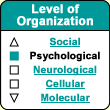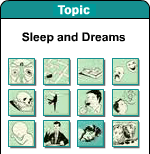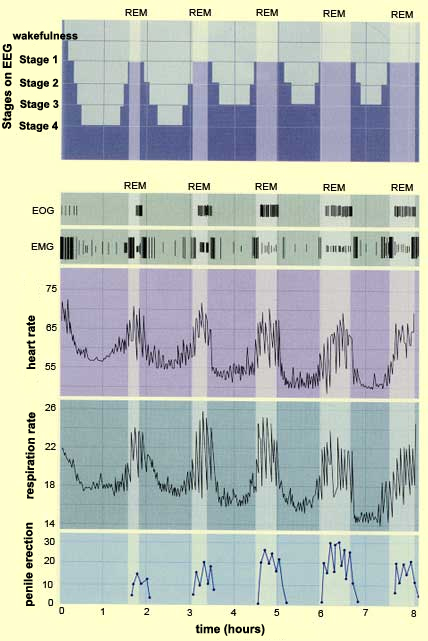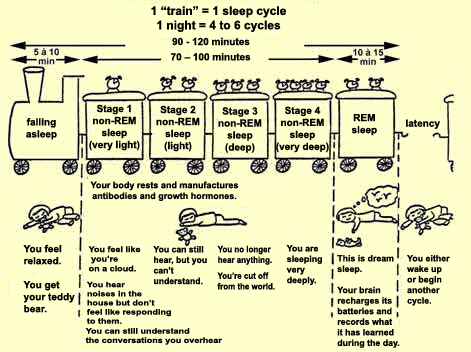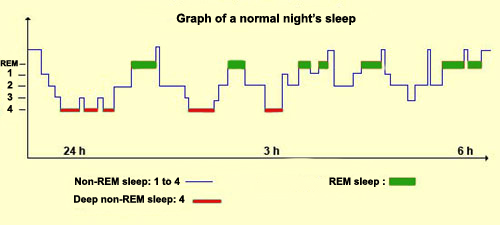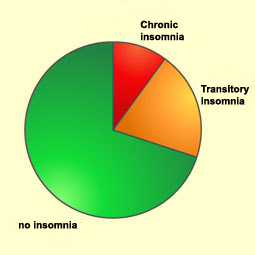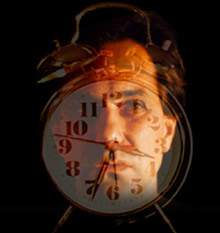|
|
| Funding for this site is provided by readers like you. | |
|
|
|
|
|||||
|
|
|||||||
|
|
|
|
| |
| |
Each of us spends about one-third of our life asleep. Or, to put it another way, by the time you’re 75, you will have spent 25 years sleeping. Sleep is part of the life of all higher vertebrates. Suppressing sleep for an extended period has dramatic effects on an organism’s physiological equilibrium. In short, sleeping is almost as important as eating or breathing. And yet, scientists still don’t know exactly why we sleep! Incredible as it may seem, despite our increasingly detailed knowledge of the mechanisms that make us fall asleep each night, we know very little for certain about the role that sleep plays (follow the Tool Module link to the left). In purely operational terms, sleep can be defined as a reversible state of reduced sensory and motor interaction with the environment. Coma (see sidebar) and anaethesia are not immediately reversible; hence, they are states distinct from sleep. In the 1950s, researchers studying sleep by means of electroencephalography (follow the Tool Module link to the left) found that sleep is far from a passive, unitary phenomenon with the sole purpose of helping the mind and body recover from the day’s wear and tear. On the contrary, the researchers found differing patterns of brain waves that let them differentiate two kinds of sleep: non-REM sleep and REM (or paradoxical) sleep. When we analyze the characteristics of these two states of sleep, and the state of wakefulness, we find important physiological differences among them in many different systems of the body. - The electroencephalograph (EEG) traces for brain activity during wakefulness and during REM sleep show a similar pattern: low-amplitude, high-frequency waves. In contrast, non-REM sleep is characterized by waves with a higher amplitude and a lower frequency. - When you’re awake, your sensations are vivid and originate in the external environment. During REM sleep, when you are dreaming, your sensations also are vivid, but are generated internally. During non-REM sleep, sensations are completely absent or very attenuated. - When you’re awake, your motor activity is voluntary and practically constant. During non-REM sleep, it is occasional and involuntary. And during REM sleep, it is non-existent, except for the rapid eye movements after which REM sleep is named (what actually happens is that your brain sends out commands for your muscles to move, but these commands are blocked and not executed, resulting in generalized muscle atonia). - Eye movements are thus very frequent both when you are awake and when you are dreaming (i.e., when you are in REM sleep), but rare during non-REM sleep. - Thought, which is fairly linear and logical when you are awake, becomes repetitive during non-REM sleep and outright bizarre and illogical during your dream (REM) sleep. Non-REM sleep, which is divided into four distinct stages, seems to be designed specifically for resting. You muscles are more relaxed, and you move them only infrequently, to adjust your body’s position in bed. As the parasympathetic nervous system becomes predominant during this phase of sleep, your general metabolism slows down: your temperature, energy consumption, heart rate, respiration rate, and kidney function are all reduced. The slow brain waves recorded on EEGs during non-REM sleep indicate that the brain too seems to be resting. The extensive synchronization of neural activity observed in the brain during non-REM sleep (orchestrated by the thalamus, in a departure from its usual role as a switch) provides further evidence that most of the sensory information from the outside world doesn’t even reach the cortex during this kind of sleep. It is no surprise that in experiments where people are awakened from non-REM sleep, they can recall only vague thoughts and, on rare occasions, detailed dream scenes. William Dement, an important sleep researcher, has summarized non-REM sleep as an idling brain in a moving body.
Conversely, Dement describes REM sleep as the state of an active, hallucinating brain in a paralyzed body. In the mid-1950s, Dement and his colleagues Eugene Aserinsky and Nathaniel Kleitman began running experiments in which they awakened people from REM sleep and discovered that the vast majority of them reported that they had been dreaming. And these subjects could in fact provide detailed accounts of the events in their dreams, sometimes resembling real life but often with some bizarre features. People’s behaviour and the physiological changes that their bodies undergo during REM sleep are just as strange. For instance, their EEG traces display high-frequency, low-amplitude waves not unlike those recorded when they are awake. In addition, they display the rapid eye movements characteristic of REM sleep, accompanied by pontogeniculooccipital (PGO) spikes on their EEG traces. And 90 to 95% of the people who are awakened from REM sleep say that they had been dreaming. During REM sleep, the brain’s oxygen consumption, which reflects its energy consumption, is very high–even higher than when someone is awake and thinking about a complex cognitive problem. Equally remarkable is the almost total loss of muscle tonus during REM sleep, which means that we are literally paralyzed while we are dreaming, except that our respiratory and cardiac muscles maintain “essential services” and our eye muscles remain active, producing the rapid eye movements characterizing this form of sleep. (The small muscles of the middle ear also remain active.) During REM sleep, the body’s inner temperature is no longer well regulated and tends to shift toward the temperature of its surroundings, just as in reptiles. Because human babies spend tremendous amounts of time in REM sleep, care must be taken to keep the rooms where they sleep at a suitable temperature, so that they don’t suffer from excessive fluctuations in body temperature. Heart and respiratory rates increase during REM sleep, but in an irregular fashion. And lastly, the penis becomes erect and the clitoris becomes engorged, regardless of whether the dreams in progress have any erotic content. In fact, this phenomenon can be used to determine whether a man’s impotence is of physiological or psychological origin.
|
| |||||||||||||||||||||||||||||||||||||||||||||||||||||||||||||||||||||||||||||||||||||||
|
Electroencephalograms recorded while people sleep a full night show various stages of sleep that succeed one another in very regular cycles. At around the same time every evening, we experience a feeling of fatigue, or cold, or lack of concentration that makes us want to go lie down. If we do go to bed then, we generally fall asleep quickly, in less than 10 minutes. Then we descend through all the stages of non-REM sleep, from Stage 1, which is fairly light, to Stage 4, which is very deep. Next we come back up through the heavier stages of non-REM sleep to the lighter ones. Then suddenly, we go into our first short period of REM sleep, lasting 5 to 10 minutes. This ends the first cycle of that night’s sleep. Depending on the individual, this cycle may last a total of 1½ to 2 hours from the time that sleep begins.
A complete night of sleep consists of a series of 4, 5, or sometimes 6 of these cycles. At the end of the period of REM sleep that closes each cycle, there is a moment when waking up is very easy and people very often do so briefly. Generally these brief awakenings last less than 3 minutes, and often all people do with them is change body position (later, they retain no memory of having been awake). Then the next cycle begins. But if someone is overstimulated, it can take an entire cycle for them to fall asleep again. These periods of being awake are longer and more common after the first two cycles of sleep have been completed. That’s why so many people find themselves awake from about 4:00 AM to 6:00 AM, after which they finally succeed in falling back into a deep sleep.
When you fall asleep again after having been awake during the night, you have to go back down through all the stages of non-REM sleep. (Going from a state of wakefulness directly into a period of REM sleep is characteristic of a sleep disorder called narcolepsy.) Though
all of the sleep cycles in a night last about the same amount of time, their composition
changes as the night goes on. In the first third of the night, deep non-REM sleep
predominates. In fact, the first two sleep cycles include almost all of the deep
non-REM sleep that a person gets in the course of the night. Toward the end of
the night, however, a higher proportion of each cycle consists of light non-REM
sleep and REM sleep, and the periods of REM sleep can last from 30 to 50 minutes.
However, a period of at least 30 minutes of non-REM sleep between periods of REM
sleep still seems to be necessary even toward the end of the night. |
|
There is still plenty of uncertainty about the function or functions of sleep in general (follow the Tool Module link to the left). But the possible functions of dreams and the mechanisms that make us have them remain even more mysterious. That is why there are such a wide variety of theories that attempt to explain dreams and to characterize the relationship between dreams and REM sleep. Some of these theories are mutually compatible, while others are mutually exclusive. Here is an overview of some of the most controversial ones. In the psychoanalytic theory of the famous Viennese neurologist Sigmund Freud, dreams are a window into the unconscious, revealing desires and feelings that we have repressed since earliest childhood. In The Interpretation of Dreams, published in 1899, Freud suggested that dreams allow us to fulfil these unrecognized desires, to express sexual and aggressive fantasies that we cannot act out in waking life, or to prepare ourselves to cope with situations that cause us anxiety. According to psychoanalytic theory, the interpretation of our dreams could therefore help us to better understand our conscious psychological lives.
In 1977, Harvard University scientists J. Allan Hobson and Robert McCarley proposed their activation-synthesis model of dreams. This was the first neurobiological model of the origin of dreams that explicitly rejected Freudian psychological interpretations. According to this model, the images that we see in dreams originate in totally random nerve impulses, triggered by the release of acetylcholine by the REM-On cells in the brainstem, and the sleeping brain does exactly the same thing with these impulses as it does with ambiguous visual signals that it receives while we were awake: it attempts to assign them a meaning. In this model, dreams are thus nothing more than the brain’s desperate attempts to extract coherent images from the confusing signals transmitted by the pons (including PGO spikes ). The result of these efforts each night would then be the strange stories told by our “cinema of the mind”, an amalgam of our concerns of the moment, remembered events, and the emotions associated with them. Hence this model is not very compatible with the theories of Freud. It sees dreams as being triggered not by psychological phenomena such as the expression of unavowed or repressed desires, but rather by simple biochemical feedback loops between some areas of the brain that are phylogenetically very old and others that are more recent. This theory provoked a general outcry among psychoanalysts, even though it received several experimental confirmations in the years after Hobson and McCarley first proposed it. In 1983, Francis Crick and Graeme
Mitchison suggested that dreams are a way that the brain does “housecleaning”
to prevent too great a build-up of the information that it receives over the years.
This theory is thus based on the assumption that over the long term, an excess
of information could impair the activities by which the cortex stores memories. In 1986, Crick and Mitchinson further posited that obsessive ideas are the main kind of information that the brain eliminates by means of dreams. This hypothesis thus bore a substantial resemblance to Freud’s idea that dreams serve to purge the brain of harmful psychic tensions. Another explanation of the function of dreams (or at least the often strange, emotionally charged dreams associated with REM sleep) is based on the finding that babies spend 8 hours per day in REM sleep when they are newborns, and slightly more than that before they emerge from the womb. It has therefore been hypothesized that REM sleep is related to brain development. This hypothesis is supported by another observation: the muscle paralysis associated with REM sleep is not so complete in infants as in older children and adults. As a result, during REM sleep, infants who are too young even to smile at their mothers when they are awake often make facial expressions that would correspond to fundamental emotions such as happiness, fear, disgust, and surprise in adults. These expressions may be attributed to genetic programming designed to ensure basic communication among members of our species. But how does this prior knowledge encoded in the genes get transferred into the organization of the nervous system? The answer isn’t obvious, because we simply don’t have enough genes for them to guide the synaptogenesis and encode all of the brain circuits needed for these basic behaviours. For the construction of these circuits to be completed, they must be activated so that they can then participate in their own building process–what is known as epigenetic development. Some scientists believe that the activating mechanism which enables our genetically inherited wiring to be translated into the infant’s actual nervous system consists of the intense endogenous stimuli that accompany REM sleep. In Michel Jouvet’s view, this hypothesis that
dreams serve as the custodian of the memory of a species account for several phenomena–first
of all, his own experiments in which cats
whose brains had been surgically altered so that their muscles were no longer
paralyzed during REM sleep exhibited all kinds of behaviours during REM sleep
that were particular to their species. The hypothesis of epigenetic development
could also explain why, for example, a cat who has been raised in an apartment
in the city and then is allowed to roam freely in the countryside will always
know how to hunt a mouse: because she has practiced doing so every night in her
dreams. This hypothesis might also explain why human identical twins who have
been raised apart from each other sometimes have similar temperaments. But for
this “general rehearsal” explanation to make sense, we also need to
explain why adult humans, in whom the neural circuits essential for the survival
of the species have been laid down long ago, still spend nearly one-quarter of
the night in REM sleep. In fact, dreams may actually serve a number of
functions at once. Some
more recent and still hotly debated hypotheses thus propose that though dreams
have a neurobiological basis, they do still serve certain psychological functions. |
|
You don’t fully realize the importance of sleep until for some reason you stop getting enough. If the reason is a conscious decision to go short on sleep, you can counter the harmful effects of sleep deprivation by changing your priorities. But if you are building up a sleep debt because of an involuntary inability to get the quantity or quality of sleep that you need to see to your daily activities, then you are suffering from insomnia.
The causes of chronic insomnia are highly varied. The first possibilities to consider are external factors such as excessive noise, heat, or cold in the sufferer’s environment. In other cases, however, the causes are internal, sometimes of organic origin, and other times of psychological origin. Possible organic causes of chronic insomnia include known illnesses that cause pain, coughing, or difficulty in breathing. In yet other cases, chronic insomnia may be caused by pathologies associated specifically with sleep. One example is restless legs syndrome, in which the individual often experiences two different sets of symptoms. The first set are the symptoms of the syndrome itself: very unpleasant sensations of tingling or burning in the legs, accompanied by an irresistible urge to move them. These symptoms usually occur during the evening and at night. They are most likely to arise when a person’s legs are still, and are at least partly relieved if he or she moves them voluntarily. Thus restless legs syndrome can make it harder for people to fall asleep, by forcing them to get up out of bed and walk around. The second set of symptoms that can contribute to chronic insomnia, and that often accompanies restless legs syndrome, is known as periodic limb movement disorder. It involves involuntary leg movements that occur every 5 to 90 seconds while a person is in deep sleep. These movements affect the muscles of the lower limbs in general, most often causing flexion in the feet and toes, but sometimes also involving the knees and hips. These involuntary movements not only disrupt the sufferer’s sleep but can also be highly disturbing for their bedmates. Sleep apnea is another sleep
pathology, in which people stop breathing for varying periods during the night.
The sufferers are generally older men who are overweight. This condition can make
them wake up hundreds of times during the night, so that they are very tired during
the day.
Living
with insomnia is not restful, to say the least, but neither is the opposite: living
with any of the various forms of hypersomnia, of which narcolepsy
is the best known. Hypersomnias are not simply a matter of sleeping too much
in the daytime because you are not sleeping enough at night. Instead, they are
the result of a particular malfunction of the neuronal wakefulness network or
the anti-waking system. |
| |
|
|
|
|
|
|
|
|



